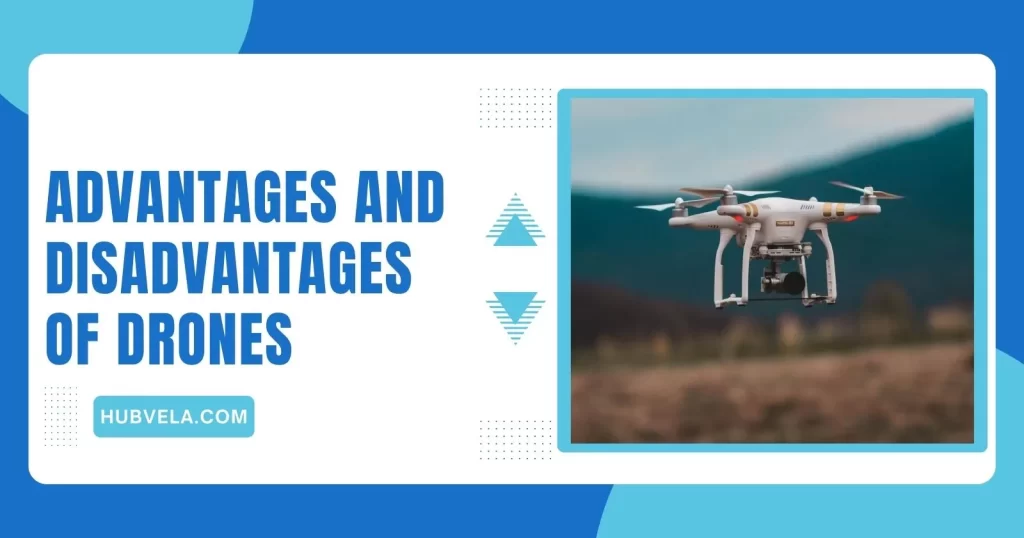The use of drones has become increasingly popular in various fields, offering numerous advantages and disadvantages. Drones, also known as unmanned aerial vehicles (UAVs), have revolutionized the way we approach tasks and operations in industries such as agriculture, film and photography, security, and more.
In this article, we will explore the advantages and disadvantages of drones in different fields, highlighting their impact on efficiency, cost-effectiveness, and safety.

--Advertisement--
Advantages and Disadvantages of Drones in Different Fields
Drones are known for their affordability, ease of deployment, and versatility. They can be used for a wide range of purposes, from capturing stunning aerial views in film and photography to monitoring crops and wildlife in agriculture.
In the field of security, drones have become an essential tool for surveillance and policing, providing a watchful eye in the sky. However, drones also come with their own set of challenges, such as limited flight time, weather restrictions, and legal issues.
As we dive deeper into the world of drones, we will examine the pros and cons of their use in different industries, shedding light on the benefits and drawbacks of this rapidly evolving technology.
Whether you are a hobbyist or a professional, understanding the advantages and disadvantages of drones can help you make informed decisions about their use in your field.
1. Business
The use of drones in business presents both advantages and disadvantages. Drones are cost-effective and environmentally friendly, as they are battery-powered and can reduce staff costs over time.
They are always operational and can access tricky places more efficiently than humans. In terms of business applications, drones are used for various purposes such as film and photography, surveillance, agriculture, and wildlife monitoring.
However, drones also have limitations, including legal restrictions on where they can be flown, safety concerns, the need for skilled operators, and high initial costs.
Despite their benefits, drones have raised privacy issues and can be limited by their flight time, dependence on technology, and weather conditions.
Therefore, while drones offer various advantages for businesses, it is important to carefully consider their limitations and potential drawbacks before integrating them into operations.
Advantages of Drones in Business
- Efficiency in Operations
- Cost Savings Potential
- Enhanced Data Collection
- Improved Safety Measures
- Versatility in Applications
- Competitive Advantage Potential
- Environmental Benefits
Disadvantages of Drones in Business
- Privacy Concerns
- Regulatory Restrictions
- Limited Payload Capacity
- Potential for Accidents
- High Upfront Costs
- Skill and Training Requirements
- Vulnerability to Hacking
I wrote a detailed article on the Advantages and Disadvantages of Drones in Business as well. You can read it to learn more.
2. Construction
Drones have become a popular tool in the construction industry due to their ability to complete survey work faster and safer than traditional land-based surveying methods.
They offer many advantages, such as improved safety, time and cost efficiency, and improved construction quality. Drones can access hard-to-reach places, avoiding the need to use potentially dangerous ladders or complex scaffolding systems.
They can quickly survey large areas and reach difficult-to-access locations, reducing the time required for inspection. However, there are also some downsides to using drones in construction, such as user privacy and security concerns, weather dependency, and flight restrictions.
Additionally, drones still have technical limitations that can impact their ability to inspect complex structures or those with limited access.
Despite these challenges, the future of drones in construction looks positive, and their use is expected to increase in the coming years.
Advantages of Drones in Construction
- Improved Project Monitoring
- Enhanced Safety Measures
- Efficient Data Collection
- Increased Productivity Levels
- Cost-Effective Solutions
- Enhanced Accuracy and Precision
- Streamlined Workflow Processes
Disadvantages of Drones in Construction
- Safety Concerns
- Limited Payload Capacity
- Weather Limitations
- Potential for Accidents
- Regulatory Challenges
- Technical Glitches and Failures
- Privacy and Security Risks
I wrote a detailed article on the Advantages and Disadvantages of Drones in Construction as well. You can read it to learn more.
3. Delivery
Drones have the potential to revolutionize last-mile delivery by bypassing traffic congestion and navigating urban areas or remote locations with limited accessibility more efficiently, resulting in significantly faster delivery times.
This speed and efficiency can enhance customer satisfaction and meet the demand for rapid deliveries. Additionally, drones offer an environmentally friendly alternative to traditional delivery vehicles, as they consume less energy and emit fewer greenhouse gases.
However, there are also disadvantages to using drones for delivery. One of the primary challenges is the existing regulations and restrictions on airspace and flight, which can limit the reach of drone delivery services.
Another drawback is the initial cost of implementing drone delivery systems, which can be high. Furthermore, drones are vulnerable to weather conditions, making them less reliable in certain situations.
Privacy concerns theft and hacking risks are also potential issues with drone delivery. While drones offer numerous advantages in terms of speed, efficiency, and environmental impact, they also present challenges related to regulations, cost, and reliability.
Advantages of Drones for Delivery
- Speed
- Convenience
- Cost-Efficiency
- Accessibility
- Reduced Traffic Congestion
- Environmental Benefits
- Innovation
Disadvantages of Drones for Delivery
- Safety Concerns
- Limited Payload Capacity
- Weather Limitations
- Privacy and Security Issues
- Potential for Accidents
- Restricted Flight Regulations
- Technological Limitations
I wrote a detailed article on the Advantages and Disadvantages of Drones for Delivery as well. You can read it to learn more.
4. Agriculture
Agricultural drones offer several advantages and disadvantages. On the positive side, they help farmers better identify farm conditions, detect wet and dry patches, and visualize the vegetation of their fields.
Drones also assist in mapping, which can lead to increased yields and cost savings. Additionally, they can be used to spray fertilizers and pesticides, reducing water and pesticide usage.
However, there are drawbacks to consider. Drones are more vulnerable to adverse weather conditions, which can limit their use.
They require basic knowledge and skills to operate, and most have a limited flight time and coverage area. Furthermore, they can be expensive, and government regulations are strict regarding their use in agriculture.
Despite their potential, it’s important for farmers to weigh the pros and cons before integrating drones into their agricultural practices.
Advantages of Drones in Agriculture
- Increased Crop Yield
- Efficient Pesticide Application
- Real-Time Data Collection
- Early Pest Detection
- Reduced Labor Costs
- Precision Farming Techniques
- Improved Crop Monitoring
Disadvantages of Drones in Agriculture
- Limited Flight Time
- Regulatory Restrictions
- High Initial Cost
- Skill and Training Required
- Privacy Concerns
- Vulnerability to Weather
- Limited Payload Capacity
I wrote a detailed article on the Advantages and Disadvantages of Drones in Agriculture as well. You can read it to learn more.
5. Military
Military drones offer several advantages, including enhanced battlefield strategy, extended combat range, and reduced risks to human life.
They provide real-time data and situational awareness, facilitating rapid decision-making and greater accuracy in targeting.
Drones also minimize casualties and loss of human life by reducing the risks to civilians. Additionally, remote missions with drones are believed to be physically, emotionally, and mentally less stressful for military personnel.
On the other hand, the disadvantages of military drones include potential injuries and damages, stress on personnel, and concerns about the use of force and human rights.
Despite their advantages, the issues of indiscriminate strikes and lack of accuracy in drone use also pose a threat to human rights and international regulations.
Drones are cheaper to produce and maintain, have fewer military lives at risk, and can be operated from a distance, reducing the possibility of human error during operations.
However, they also pose challenges in evaluating the effectiveness of drone strikes and have the potential for collateral damage.
Advantages of Drones in Military
- Enhanced Surveillance Capabilities
- Precision Strikes From Afar
- Reduced Human Risk
- Faster Response Time
- Extended Operational Range
- Cost-Effective Military Tool
- Improved Situational Awareness
Disadvantages of Drones in Military
- Lack of Human Control
- Potential for Collateral Damage
- Vulnerability to Hacking
- Ethical Concerns
- Psychological Impact on Operators
- Limitations in Target Selection
- High Cost of Maintenance
I wrote a detailed article on the Advantages and Disadvantages of Drones in Military as well. You can read it to learn more.
6. Logistics
Drones have emerged as a promising technology in the logistics industry, offering numerous advantages and challenges. One of the primary benefits of using drones in logistics is the potential for reduced wait times, as most drone delivery systems are semi-automated, allowing drones to be deployed quickly.
This is particularly beneficial for remote areas, where drones can deliver life-saving necessities like medical supplies and appliances.
Additionally, drones can help logistics firms reduce their fuel consumption and carbon footprint by using them at the end of the supply chain.
However, there are also several disadvantages to consider. Drones have inherent limitations in terms of payload capacity and range, making them more suitable for small and lightweight packages.
They are also subject to regulatory challenges, such as airspace regulations and flight restrictions. Furthermore, drones face privacy concerns, as they may be seen as an invasion of privacy by some consumers.
Additionally, the initial cost of implementing drone delivery systems can be high, and there is a risk of theft and hacking.
While drones offer significant advantages in terms of speed, efficiency, and environmental impact, they also present challenges related to payload capacity, range, regulations, privacy, and cost.
As the technology continues to evolve, it is essential to address these challenges to fully realize the potential of drones in the logistics industry.
Advantages of Drones in Logistics
- Time-Saving Deliveries
- Cost-Effective Transportation
- Accessibility to Remote Areas
- Enhanced Efficiency in the Supply Chain
- Reduced Carbon Footprint
- Real-Time Tracking Capabilities
- Potential for Increased Productivity
Disadvantages of Drones in Logistics
- Safety Concerns
- Limited Payload Capacity
- Weather Restrictions
- Regulatory Challenges
- Privacy Issues
- High Initial Cost
- Technological Limitations
I wrote a detailed article on the Advantages and Disadvantages of Drones in Logistics as well. You can read it to learn more.
7. Surveying
Drone surveying has several advantages over traditional surveying methods, including speed, safety, accuracy, and cost-effectiveness.
Drones can scan up to 700 acres a day and data can be ready for final delivery within two weeks. There’s no need to put people on your team in harm’s way as the drone can be piloted from a safe location while the drone itself is high above the ground.
Moreover, drones can be used to survey areas that are difficult or dangerous for human surveyors to access, such as steep slopes or remote locations.
Drones are less expensive to operate than traditional ground-based equipment, making aerial surveying a more cost-effective option.
However, there are also some downsides to consider, such as the high cost associated with purchasing, maintaining, and operating drones, as well as the limitations posed by adverse weather conditions.
Advantages of Drones in Surveying
- Increased Efficiency
- Cost-Effective Data Collection
- Enhanced Accuracy and Precision
- Improved Safety Measures
- Quick Data Processing
- Versatility in Terrain Coverage
- Remote Access and Monitoring
Disadvantages of Drones in Surveying
- Safety Concerns
- Limited Flight Time
- Weather Dependency
- Costly Equipment Maintenance
- Data Processing Challenges
- Privacy Issues
- Regulatory Restrictions
I wrote a detailed article on the Advantages and Disadvantages of Drones in Surveying as well. You can read it to learn more.
8. War
Drones, or Unmanned Aerial Vehicles (UAVs), have become an increasingly prominent tool in military operations in recent years.
The advantages of using drones in warfare include precision strikes, reduced risk to human life, and lower costs. Drones can conduct targeted killing of high-value targets, reducing the risk of collateral damage and civilian casualties.
With drones being remote-controlled, there is no need to put human soldiers in harm’s way, which can significantly reduce casualties in combat operations.
Drones can also stay in operation for significantly longer hours of operation without fatigue, and drone pilots or operators can easily hand off the controls of a drone without any operational downtime.
However, the drawbacks of using drones in warfare include potential collateral damage, ethical implications of remote-controlled killing, and concerns about the effectiveness of drone strikes.
Despite the precision of drone strikes, there is still the potential for collateral damage, and the use of drones in warfare raises ethical questions about the use of remote-controlled killing.
Additionally, it can be difficult to evaluate the effectiveness of drone strikes, and there are concerns about the potential for misuse of the technology.
Advantages of Drones in War
- Precision Targeting
- Enhanced Surveillance Capabilities
- Reduced Risk to Soldiers
- Cost-Effective Warfare Option
- Increased Operational Range
- Quick Response Time
- Ability to Gather Intelligence
Disadvantages of Drones in War
- Civilian Casualties
- Lack of Human Judgment
- Psychological Impact on Operators
- Vulnerability to Hacking
- Ethical Concerns
- Potential Misuse by Governments
- Impersonal and Detached Warfare
I wrote a detailed article on the Advantages and Disadvantages of Drones in War as well. You can read it to learn more.
Conclusion on Advantages and Disadvantages of Drones
The use of drones presents both advantages and disadvantages. Some of the pros include being environmentally friendly, cost-effective, always operational, providing improved access, and reducing risk.
Drones are also used for various commercial purposes such as film and photography, surveillance, agriculture, and wildlife monitoring.
However, there are also cons to consider, such as limited capabilities, legal limitations, safety concerns, the need for specialized training, and high initial costs.
Additionally, factors like limited flight time, weather restrictions, and privacy issues are among the drawbacks of drone technology.
Ultimately, the decision to use drones for commercial purposes requires a careful consideration of these pros and cons to determine if it is the right move for a specific application or industry.
Relevant Resources
Advantages and Disadvantages of Drones for Delivery
Advantages and Disadvantages of Drones in Agriculture
Advantages and Disadvantages of Drones in Business
Advantages and Disadvantages of Drones in Construction
Advantages and Disadvantages of Drones in Logistics
Advantages and Disadvantages of Drones in Military
Advantages and Disadvantages of Drones in Surveying
Advantages and Disadvantages of Drones in War


